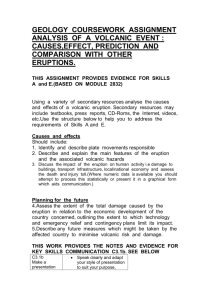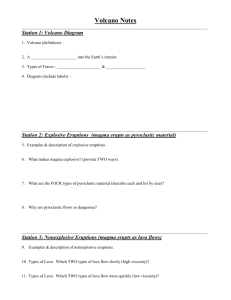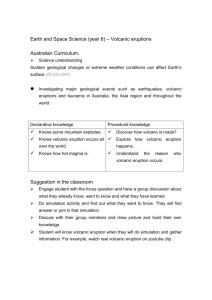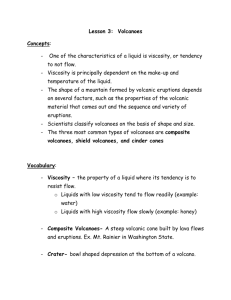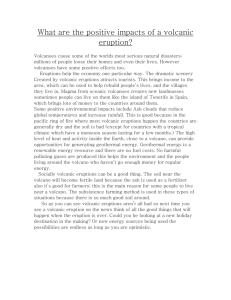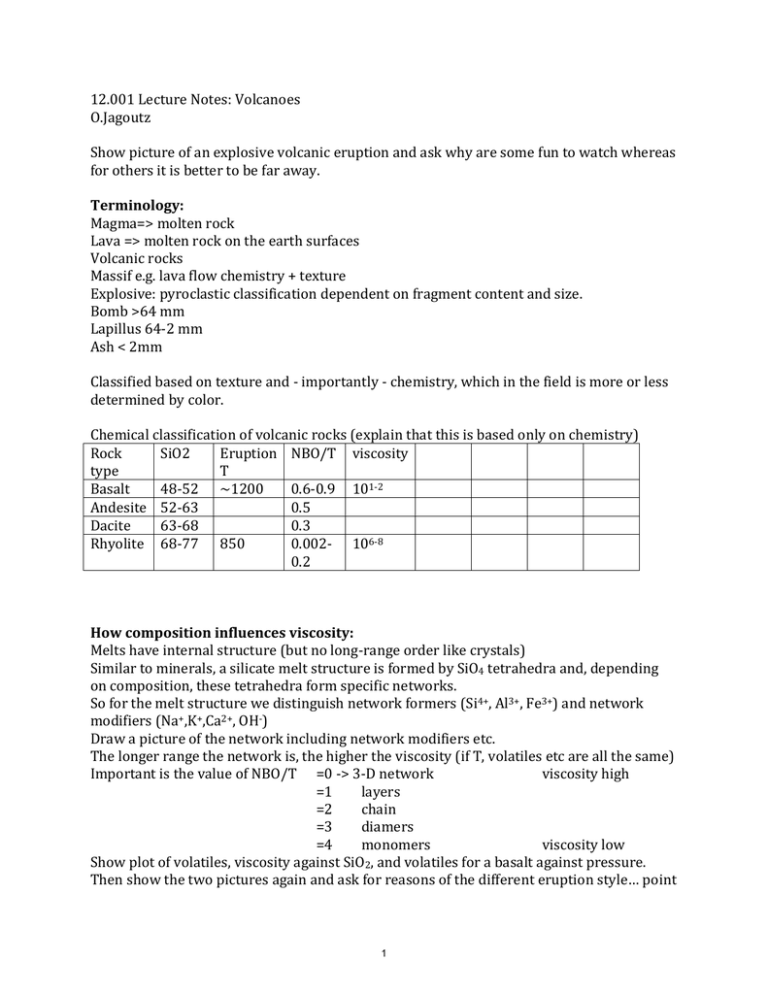
12.001 Lecture Notes: Volcanoes
O.Jagoutz
Show picture of an explosive volcanic eruption and ask why are some fun to watch whereas
for others it is better to be far away.
Terminology:
Magma=> molten rock
Lava => molten rock on the earth surfaces
Volcanic rocks
Massif e.g. lava flow chemistry + texture
Explosive: pyroclastic classification dependent on fragment content and size.
Bomb >64 mm
Lapillus 64-2 mm
Ash < 2mm
Classified based on texture and - importantly - chemistry, which in the field is more or less
determined by color.
Chemical classification of volcanic rocks (explain that this is based only on chemistry)
Rock
SiO2
Eruption NBO/T viscosity
type
T
Basalt
48-52 ~1200
0.6-0.9 101-2
Andesite 52-63
0.5
Dacite
63-68
0.3
Rhyolite 68-77 850
0.002- 106-8
0.2
How composition influences viscosity:
Melts have internal structure (but no long-range order like crystals)
Similar to minerals, a silicate melt structure is formed by SiO4 tetrahedra and, depending
on composition, these tetrahedra form specific networks.
So for the melt structure we distinguish network formers (Si4+, Al3+, Fe3+) and network
modifiers (Na+,K+,Ca2+, OH-)
Draw a picture of the network including network modifiers etc.
The longer range the network is, the higher the viscosity (if T, volatiles etc are all the same)
Important is the value of NBO/T =0 -> 3-D network
viscosity high
=1
layers
=2
chain
=3
diamers
=4
monomers
viscosity low
Show plot of volatiles, viscosity against SiO2, and volatiles for a basalt against pressure.
Then show the two pictures again and ask for reasons of the different eruption style… point
1
out the importance of volatiles for volcanic eruptions and explain that volatiles are
considered the key factor for volcanic eruptions in general - show a pumice.
Show principal make-up of a volcano: vent, magma chamber, feeder system
Explain the important internal and external forcing mechanisms that trigger eruption
(Schminke book Fig 4.31)
Explain calderas and the size of volcanic eruptions; Long Valley caldera and Yellowstone.
Mention flood basalts and the Siberian Traps with 1-4 million km3 of lava.
Courtesy of the U.S. Geological Survey. Image in the public domain.
2
© source unknown. All rights reserved. This content is excluded from our Creative
Commons license. For more information, see http://ocw.mit.edu/help/faq-fair-use/.
Courtesy of Elsevier, Inc., http://www.sciencedirect.com. Used with permission.
Source: Courtillot, Vincent E., and Paul R. Renne. "On the Ages of Flood Basalt
Events." Comptes Rendus Geoscience 335, no. 1 (2003): 113-40.
Eruption style and volcano shape
Shield volcanoes, e.g. Hawaii. Large areal extent.
Stratovolcano: Mt St Helens - mix of explosive eruptions and lava flows.
Cones: small eruptions usually of relative high viscosity magma
Special type of eruption: Phreatomagmatic
3
Courtesy of Geological Society of America. Used with permission.
Source: White, J. D. L., and M. K. McClintock. "Immense Vent Complex Marks Flood-basalt
Eruption in a Wet, Failed Rift: Coombs Hills, Antarctica." Geology 29, no. 10 (2001): 935-8.
Food for thought: since interaction with water triggers explosive eruption why don’t we
generally see explosive eruptions along the oceanic ridges?
© source unknown. All rights reserved. This content is excluded from our Creative
Commons license. For more information, see http://ocw.mit.edu/help/faq-fair-use/.
4
MIT OpenCourseWare
http://ocw.mit.edu
12.001 Introduction to Geology
Fall 2013
For information about citing these materials or our Terms of Use, visit: http://ocw.mit.edu/terms.


